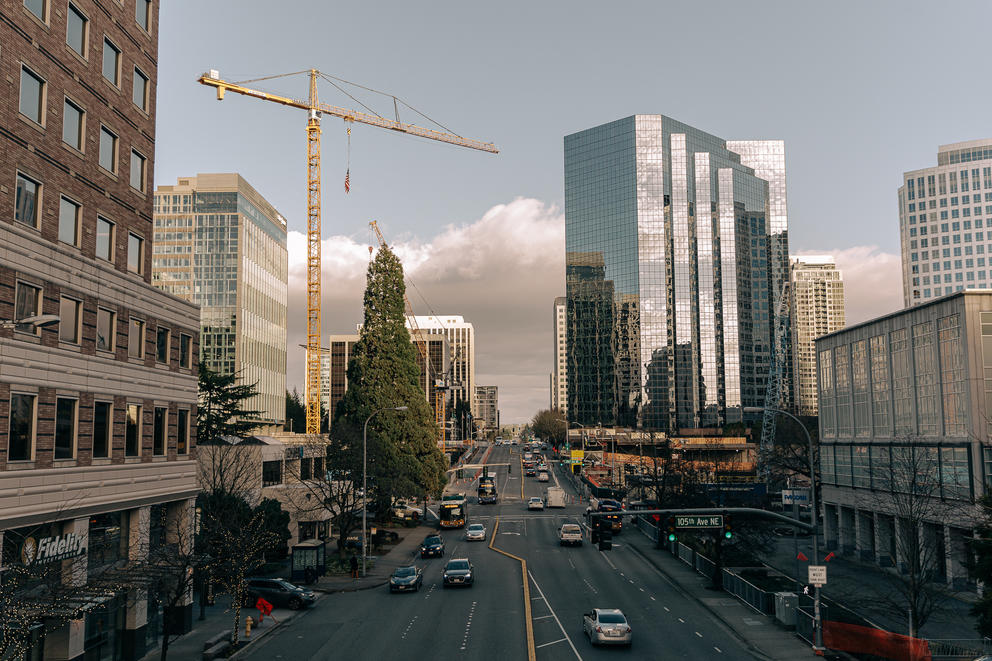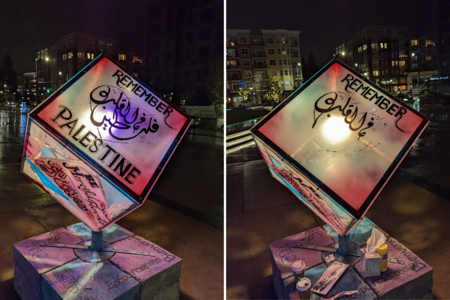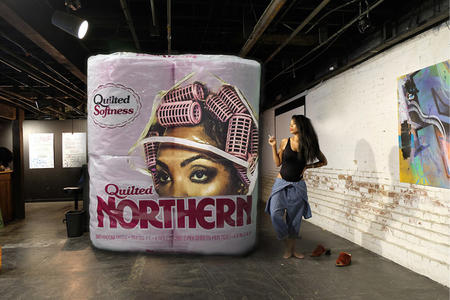“This street, 110th — especially in this part of town — is going to be the Times Square of Bellevue,” says Cullom, founder and CEO of EastHUB, a new Microsoft- and private philanthropy-funded nonprofit that will help develop the $105 million multiuse theater. “It’s going to be where everything is happening, and this playhouse is going to be right in the middle of it.”
Cullom, the former CEO of PACE/Tateuchi Center, a Bellevue playhouse in the works since the early 2000s, founded EastHUB right before the pandemic hit. With local construction continuing to boom despite the shutdowns and supply-chain issues, Cullom saw an opportunity to embed cultural spaces in the many new developments — and to market the Eastside as a cultural destination.
“[Technology] is what’s driven the economy, driven the conversation, driven where buildings go and where people live and why people move to the area,” Cullom says. “Our goal is to make sure that as we build and as this incredible pace of development moves forward, we are keeping in mind that the region needs a cultural soul — that it’s not just a place where people work. It also has to be a place where people and families live. That hasn’t been the reputation of the Eastside…. We want to change people’s minds about that: arts and culture do flourish on the Eastside.”
Much has yet to materialize, but EastHUB hopes to build more than a dozen new art spaces — including theaters, dance studios, recital halls, exhibit spaces and live music venues — within the next five to seven years.
Left: Bellevue currently boasts many public art pieces, including Dan Corson’s ‘Root’ at Bellevue City Hall. Right: Cranes rise above ongoing construction projects in downtown Bellevue. The major employers in the region, says Ray Cullom of new arts nonprofit EastHUB, share with local government and arts groups the desire for a place that is livable for families — a place with “a heart and soul.” (David Jaewon Oh for Crosscut)
The nonprofit, which has a staff of seven, will also operate as a sort of “broker” for Eastside arts organizations, to connect them with each other and advocate for the needs of the sector at various levels of government. Plus, it will help smaller arts organizations with “backend” services, including accounting, graphic design or navigating rental laws. For the past two years, the nonprofit has held roundtables, conversations and surveys across the region to figure out the gaps, needs and issues across the sector (one thing that has emerged: demand for more rehearsal space and spaces without religious affiliation).
“The goal is to allow arts and culture groups to spend less of their time and resources on administrative and real estate management tasks and more of their time on pursuing their missions and engaging with their audiences,” Cullom says. “One of the biggest traps a lot of arts organizations fall into is this dream of owning a theater or operating a space. What organizations find very quickly is that they stop becoming an arts organization, and they become a real estate management company that sometimes does art.”
While the realization of EastHUB’s unnamed playhouse is still years out — groundbreaking is slated for next year — the group is making its first public move this month. On Feb. 23, in a partnership with the city of Bellevue, the nonprofit is launching a new website, EastsideLive.org, which will be an online (you guessed it) hub where residents and art groups can find a calendar of events and a handy roster of Eastside cultural groups and art spaces.
“We want to create a platform where artists and organizations get to talk about what it is that they’re doing,” Cullom says. “And then [we’ll] work over the next many years on bringing new spaces online, creating shared resources and services between arts and cultural organizations on the Eastside — we want to help all of that grow and flourish.”
Cullom is not the only one dreaming of a bigger, better Bellevue with arts at its heart. The city, and the Eastside at large, has long wished to emerge from Seattle’s shadow, both commercially and artistically speaking. In anticipation of the light rail connection across Lake Washington (the first set of Eastside stations are slated to open in 2023), the Eastside cities of Bellevue and Redmond have cooked up public art plans for transformation into world-class art destinations.
In 2016, Bellevue hired Seattle-based artists John Sutton, Ben Beres and Zac Culler of SuttonBeresCuller to help rebrand and catalyze a lively arts scene in downtown Bellevue by 2025. According to the resulting Grand Connection art plan for Bellevue, the city will have a “pedestrian and cultural pathway” dotted with cultural venues, sculptures, murals and artist-designed canopies slicing through downtown from the light rail to the water.
Around the same time, the city also solicited the artists to refresh the city’s longtime biennial arts festival, Bellwether, in an effort to capture the attention of the throngs of daily commuters heading into town. “We want those commuters to know Bellevue has more to offer than shopping,” a city official told Crosscut at the time. “We want them to start to see Bellevue as a vibrant community where they can participate in culture, too.”
Much like Bellevue, Redmond aspires to become “a dynamic city where art is intrinsic to its vibrancy and character,” the city’s Public Art Master Plan 2016-2030 reads.
In the past decades (thanks to Microsoft) and past years (thanks to Amazon and Meta/Facebook), the Eastside has grown into a major tech player. Development has boomed and the region has seen an influx of younger residents while the population has grown more diverse, according to census data. While there are some high-caliber arts institutions in the region, a wealth of community arts groups and some strides made in the public art plans, the Eastside remains better known for its businesses than cultural offerings.
In Seattle, arts organizations have long struggled to lure tech workers to cultural spaces. Can the Eastside do better? Can Bellevue become, as some have proclaimed or prophesied, “the next Williamsburg” or the “region’s new ‘it’ city” — and can EastHUB make a difference?
Erik Hall, who operated a gallery in downtown Bellevue from 2006 through 2018, says he really wants the effort to succeed — but he’s skeptical. “I’ve watched this sort of thing try to get off the ground several times in Bellevue to no avail,” he says. “People underestimate the [work required] to bring…people together around something like the arts.”
Hall is wary of the “disruptor” story of one organization swooping in to fix the art scene with grand gestures. He says what is needed is more of a concerted effort for boutique businesses to survive in the downtown core by allowing creative solutions for leases and more flexible granting options, not necessarily one major new arts center.
Take the Tateuchi Center (née PACE, for Performing Arts Center Eastside, now PACE again), Spassov says. The proposed 2,000-seat performing arts center in downtown Bellevue has been in the works for two decades, stuck in a perpetual state of fundraising. For a while, the organization was helmed by Cullom, who left in late 2019 and didn’t want to say much about what the rub had been at PACE.
“PACE is an arts and culture group,” Cullom says, by way of clarification. “They are continuing to pursue the vision of building the 2,000-seat performing arts complex that they’ve been working on since their inception.” Cullom later added: “We feel that when we’re successful, they will be.”
EastHUB’s still-unnamed center, which will be able to host up to 1,200 people, is set to rise just a stone’s throw from where PACE will perhaps stand one day. The new playhouse/all-purpose arts space will be nestled in the middle of the three skyscrapers that constitute Cloudvue, a major new downtown development between the Meydenbauer Center Theatre, where many of the performing arts events in downtown Bellevue currently take place, and the Bellevue Arts Museum.
The first $45 million needed for the EastHUB arts center was provided by Cloudvue, which donated the land, a new garage, as well as site clearing and other work. (According to the organization, it is one of the largest donations to Eastside arts and culture ever.) Last month, EastHUB started its push for a capital fundraising campaign for the remaining $60 million.
“We see it as a real community center,” Cullom says. Though the details are still in flux, the center could host performances by local dance and theater groups, visiting musicians from the Seattle Symphony (and other Seattle arts groups) and high-profile bands, but also galas and occasionally “a meeting or a product launch,” Cullom says. “The idea is that it’s open from first thing in the morning until late at night. It’s not just a building where art happens between, you know, 8 and 11 p.m.”
But ultimately, says Cullom, it’s the community that will help shape what the center looks like, how many people it seats and what it will end up being used for. “We’re not telling them — we’re building for them.”
Get the latest in local arts and culture
This weekly newsletter brings arts news and cultural events straight to your inbox.









